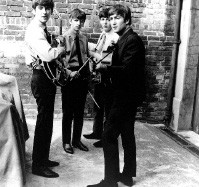From the limousines the Beatles sent to meet the Stax-Volt Revue at Heathrow Airport in March 1967 to Booker T. & the MGs’ McLemore Avenue album, released three years later as a homage to the Fab Four’s Abbey Road, there was plenty of mutual appreciation flowing between England’s biggest export and Memphis’ homegrown heroes.
“The Beatles came to the club we were playing in, the Bag O’Nails in London, and bowed to us,” MGs bassist Donald “Duck” Dunn remembers with a chuckle. “It made me feel like a million dollars, I guess. To tell you the truth, when the Beatles were on Ed Sullivan, the Dave Clark Five appeared the following week, and I turned to my wife and said, ‘Now there’s a good band.’ She was going crazy over the Beatles, and I didn’t want to like them.”
“Of course, George [Harrison] wasn’t there,” MGs guitarist Steve Cropper laments. “It was an honor. It was really great. But the guitar player wanted to meet the guitar player. Later on in the ’70s, I met him in Beverly Hills, and we got to hang out some, which was a big thrill for me.”
Yet few classic-rock fans know that exactly a year before the London meeting, the Beatles were slated to cut an album at Stax Records.
On March 31, 1966, the Memphis Press-Scimitar newspaper reported that the Beatles were due at 926 East McLemore on April 9th, spending two weeks working a new album before embarking on an extensive U.S. tour.
“There was a close relationship between England and what we were doing down here,” Cropper explains. “Otis [Redding] enjoyed playing for English audiences, because he was so respected over there. And the Beatles started out as a cover band, listening to a lot of Sun material like Carl Perkins and Jerry Lee Lewis.”
“The thing that was interesting to me was the fact that the Beatles’ tunes were rhythm-and-blues tunes,” says Johnny Keyes, a staff songwriter at Stax in the ’60s. “The same thing with the [Rolling] Stones. All of these British artists had more respect for our music, especially the blues, than the people who lived in Memphis.”
Brian Epstein, the Beatles’ manager, arrived in town in early April to suss out the studio and security situation, and everything seemed ready to go.
 Courtesy EMI Records
Courtesy EMI Records
“All the secretaries were saying, ‘You have to promise not to repeat this, but the Beatles are coming!'” Keyes recalls. “We had a songwriters’ meeting, because we thought they were looking for rhythm-and-blues material. Ronnie [Gorden, the Bar-Kays’ keyboardist] happened to be around, so he and I worked on a tune called ‘Out of Control,’ which had lyrics like, ‘Without you pretty baby, I’m like a dog without a tail/Like a church without a bell.’
“In the meantime,” says Keyes, “the information leaked out. Girls were coming into the Satellite Record Shop about to cry, saying, ‘If you talk to Paul McCartney, please, please let me know.’ Word spread, and WHBQ came in and asked [Stax co-owner] Ms. [Estelle] Axton about it, but she played coy with them.”
“I was so excited about it,” says Deanie Parker, the former Stax publicist who went on to serve as the CEO and president of the Stax Museum of American Soul Music. “I was seeing dollar signs. I talked to Jim Stewart and said, ‘If the Beatles do come here, will you give me permission to take the carpet up, cut it into squares, and sell it?’ Honey, I was gonna make me some money.”
“Everyone else was worrying about the logistics — how were we gonna get them from the airport,” Keyes says. “We were gonna put them up at the Holiday Inn Rivermont, but Elvis Presley said it would be better if they stayed at Graceland. It went back and forth, and Epstein ultimately left town because he didn’t want to get in the middle of it. The session never happened.”
Instead, the Beatles stayed home, cutting Revolver, which featured the Stax-inspired “Got To Get You Into My Life,” at Abbey Road, before showing up in Memphis for a one-night concert at the Mid-South Coliseum on August 19th.
“I was very disappointed,” Parker admits, “mostly because it blew my little enterprise.”
“I remember getting the call,” Cropper says. “Who knows what might’ve happened? ‘Tax Man’ could’ve been ‘Stax Man.'”
But in July and December 1973, the Stax studios were taken over by another pop giant: Elvis Presley, who recorded several sides, including “If You Talk in Your Sleep,” “I’ve Got a Thing About You Baby,” “My Boy,” and a cover of Chuck Berry’s “Promised Land” at 926 East McLemore.
“The staff was notified that after-hours the building wouldn’t be available to us because Elvis’ production crew asked for privacy,” says Parker. “It was off-limits to us for a week. I didn’t even go into the studio, because I could see Elvis around Memphis. Anytime I’d drive down Bellevue, he might be out on his motorcycle. Having Elvis at Stax was just matter-of-fact, just another session.”
“By the time Elvis showed up, I had already left to start my own studio, Trans-Maximus,” Cropper says. “But I think George Klein influenced him and made him aware of what was going on at Stax. George called me one day when I was still over there and said, ‘Elvis would like you to write him a song.’ We never really came up with anything, but Elvis had some gospel chops, and he knew his soul.”
Dunn, who was present for Presley’s sessions, says, “When Otis [Redding] sang, he projected. When Sam and Dave sang, they projected. With Elvis, he didn’t bellow it out, but it came out big. To end up so forceful, he was the softest singer I ever heard.
“He’d have an imitator come in and lay down the track with the band,” Dunn says, “and then they’d overdub his voice. I was actually a little nervous. He was Elvis: You didn’t just walk up and talk to him. As far as being buddy-buddy with him, you didn’t do it.”

